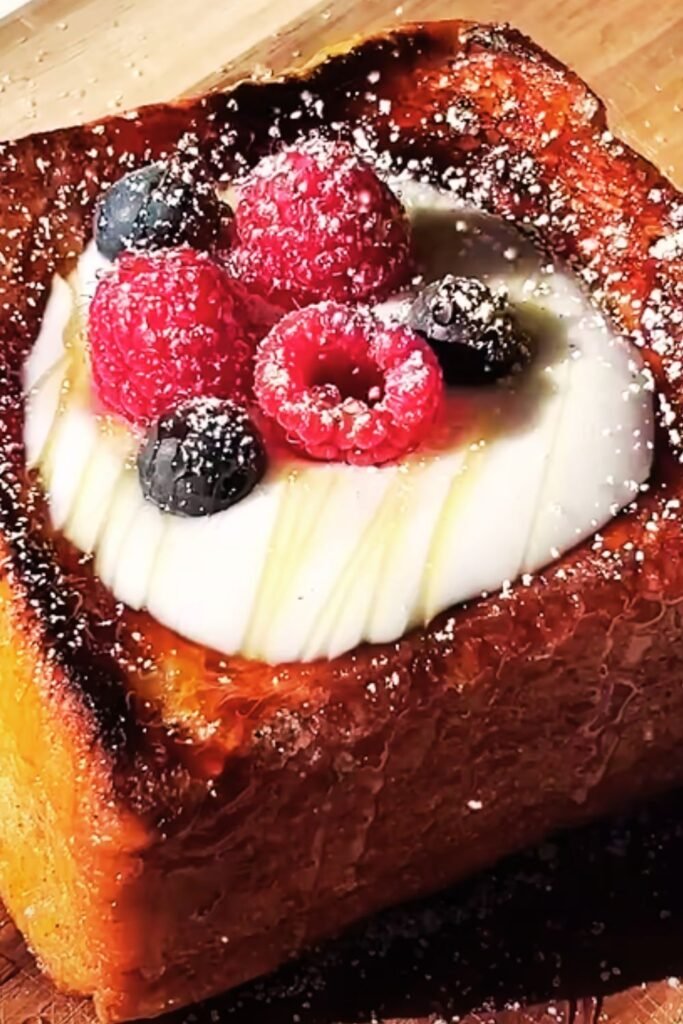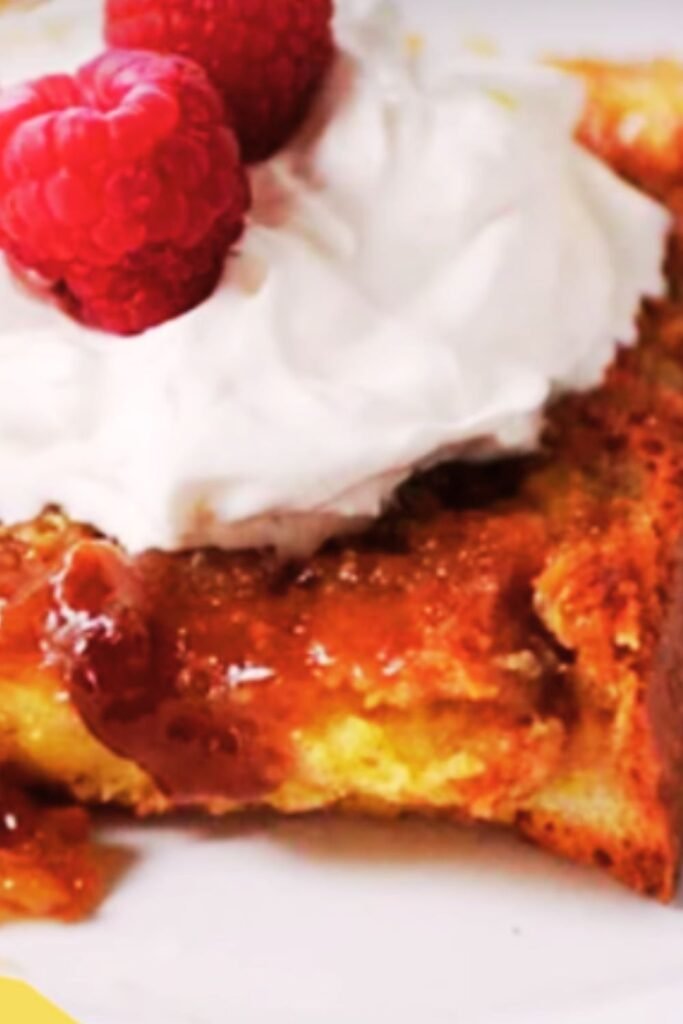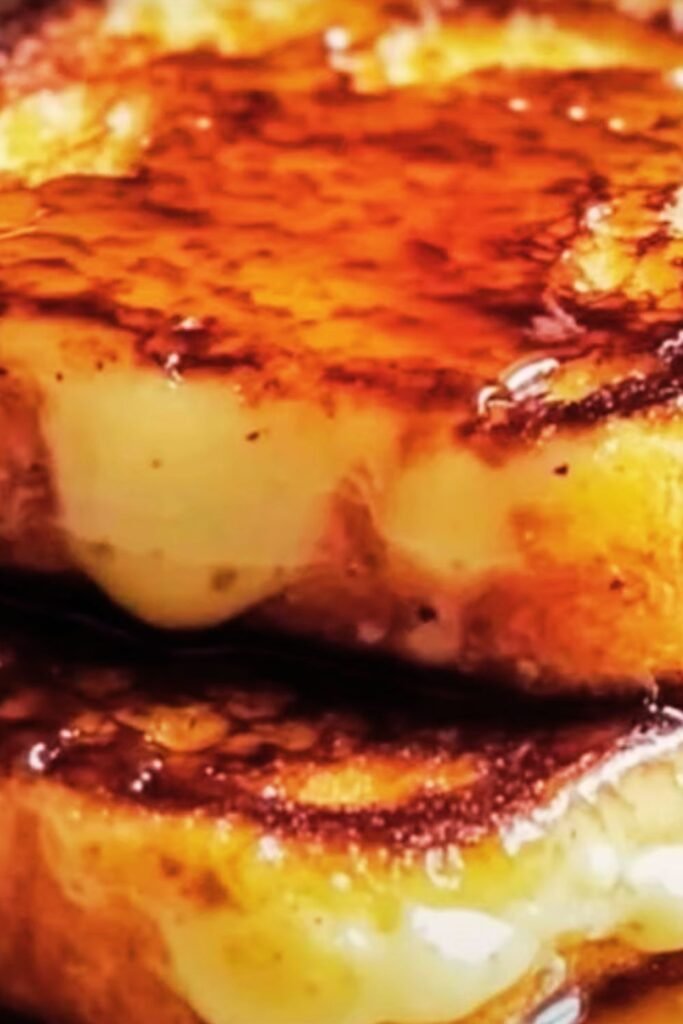I’ve always believed that the best mornings start with something extraordinary waiting for you in the kitchen. After years of experimenting with breakfast recipes, I discovered this overnight crème brûlée French toast that completely transformed my approach to weekend brunches and special occasion breakfasts. This recipe combines the rich, custardy elegance of classic crème brûlée with the comforting familiarity of French toast, all while being prepared the night before.
The genius of this dish lies in its overnight preparation. While you sleep, thick slices of brioche or challah bread absorb a luxurious custard mixture, creating an incredibly rich and creamy interior. Come morning, you simply slide the dish into the oven and watch as it transforms into golden perfection, complete with that signature caramelized sugar topping that makes crème brûlée so irresistible.
Understanding the Foundation: Key Components
Custard Base : The heart of this recipe is a rich custard made from heavy cream, eggs, and vanilla. Unlike regular French toast custard, this mixture is designed to be absorbed slowly overnight, creating an incredibly creamy texture that rivals traditional crème brûlée.
Bread Selection : The choice of bread is crucial. Thick-cut brioche, challah, or even day-old croissants work beautifully. The bread needs to be sturdy enough to absorb the custard without falling apart, yet tender enough to create that perfect custardy interior.
Caramelized Sugar Topping : This is where the magic happens. A layer of brown sugar on top caramelizes during baking, creating that signature crème brûlée crust that cracks satisfyingly under your spoon.
Overnight Soaking Process : The extended soaking time allows the custard to penetrate completely through the bread, ensuring every bite is infused with that rich, vanilla-scented cream.
Essential Ingredients and Their Roles
| Ingredient | Quantity | Purpose | Substitution Options |
|---|---|---|---|
| Brioche or Challah | 8-10 thick slices | Primary structure, absorbs custard | French bread, Texas toast, croissants |
| Heavy Cream | 2 cups | Creates rich custard base | Half-and-half (less rich), coconut cream |
| Large Eggs | 6 whole eggs | Binding agent, custardy texture | No direct substitute |
| Granulated Sugar | 1/2 cup | Sweetens custard | Coconut sugar, maple syrup (reduce liquid) |
| Brown Sugar | 1/2 cup | Caramelized topping | Turbinado sugar, coconut sugar |
| Vanilla Extract | 2 teaspoons | Flavor enhancement | Vanilla bean paste, almond extract |
| Salt | 1/4 teaspoon | Flavor balance | Sea salt, kosher salt |
| Butter | 4 tablespoons | Richness, prevents sticking | Coconut oil, ghee |
Nutritional Breakdown Per Serving
| Nutrient | Amount | % Daily Value |
|---|---|---|
| Calories | 485 | 24% |
| Total Fat | 28g | 36% |
| Saturated Fat | 16g | 80% |
| Cholesterol | 245mg | 82% |
| Sodium | 380mg | 17% |
| Total Carbohydrates | 48g | 17% |
| Dietary Fiber | 2g | 7% |
| Sugars | 32g | – |
| Protein | 12g | 24% |
Based on 8 servings using brioche bread
Step-by-Step Preparation Guide
Evening Preparation (15 minutes active time)
I always start this recipe the evening before I plan to serve it. The beauty of this approach is that most of the work happens while you’re sleeping.
Preparing the Baking Dish Begin by generously buttering a 9×13-inch baking dish. I prefer using a ceramic or glass dish because it distributes heat evenly and looks beautiful when serving. The butter prevents sticking and adds an extra layer of richness to the bottom of the French toast.
Arranging the Bread Cut your brioche or challah into thick slices, approximately 1.5 inches thick. Arrange these slices in the buttered dish, overlapping them slightly like fallen dominoes. I find that this overlapping technique helps the custard distribute more evenly and creates beautiful layers in the finished dish.

Creating the Perfect Custard In a large mixing bowl, whisk together the heavy cream, eggs, granulated sugar, vanilla extract, and salt. I whisk vigorously for about two minutes to ensure the sugar dissolves completely and the mixture becomes smooth and homogeneous. The custard should have a pale yellow color and no visible sugar granules.
The Soaking Process Pour the custard mixture evenly over the arranged bread slices. I use a large spoon to gently press down on the bread, encouraging it to absorb the custard. Cover the dish tightly with plastic wrap and refrigerate overnight, or for at least 8 hours.
Morning Baking Process (45 minutes)
Preheating and Final Preparation Remove the dish from the refrigerator about 30 minutes before baking to allow it to come to room temperature. Preheat your oven to 350°F (175°C). This temperature ensures even cooking without burning the delicate custard.
Adding the Signature Topping Remove the plastic wrap and evenly sprinkle the brown sugar over the entire surface. This creates that characteristic crème brûlée crust. I sometimes add a tiny pinch of sea salt to the brown sugar for complexity.
Baking to Perfection Bake for 40-45 minutes, until the top is golden brown and caramelized, and the center feels set when gently shaken. The internal temperature should reach 160°F (71°C) for food safety.

Timing and Temperature Guidelines
| Phase | Temperature | Time | Visual Cues |
|---|---|---|---|
| Overnight Soak | 35-40°F | 8-24 hours | Bread fully saturated |
| Room Temperature Rest | 65-70°F | 30 minutes | No condensation on dish |
| Baking | 350°F | 40-45 minutes | Golden brown, set center |
| Resting | Room temp | 10 minutes | Firmed texture |
Flavor Variations and Enhancements
Over the years, I’ve developed several delicious variations of this basic recipe that add exciting flavor dimensions.
Orange Crème Brûlée French Toast Add the zest of two oranges to the custard mixture and replace one teaspoon of vanilla with orange extract. The citrus brightens the rich custard beautifully and adds a sophisticated twist.
Cinnamon Roll Variation Mix two teaspoons of ground cinnamon into the brown sugar topping and add a teaspoon of cinnamon to the custard. This creates flavors reminiscent of a decadent cinnamon roll.
Berry Compote Addition Create a simple berry compote by cooking mixed berries with a little sugar and lemon juice. Serve alongside the French toast for a fruity contrast to the rich custard.
Chocolate Indulgence Add three tablespoons of cocoa powder to the custard mixture for a chocolate version. Top with a mixture of brown sugar and mini chocolate chips before baking.
Serving Suggestions and Accompaniments
The beauty of this dish is that it’s substantial enough to serve as the centerpiece of your breakfast or brunch table, but it also pairs wonderfully with complementary sides.
Fresh Fruit Options
- Sliced strawberries and blueberries
- Caramelized bananas with a touch of cinnamon
- Fresh peach slices during summer months
- Mixed berry medley with mint
Syrup and Sauce Pairings
- Pure maple syrup warmed with a vanilla bean
- Homemade caramel sauce
- Fresh berry coulis
- Lemon curd for brightness
Beverage Companions
- Freshly brewed coffee with cream
- Earl Grey or English Breakfast tea
- Fresh orange juice
- Sparkling water with lemon

Storage and Reheating Instructions
| Storage Method | Duration | Quality Notes |
|---|---|---|
| Refrigerator (unbaked) | Up to 24 hours | Optimal absorption time |
| Refrigerator (baked) | 3-4 days | Cover tightly |
| Freezer (baked portions) | Up to 2 months | Wrap individually |
| Room Temperature | 2 hours maximum | Food safety concern |
Reheating Guidelines When reheating leftover portions, I recommend using a 325°F oven for 15-20 minutes, covered with foil to prevent over-browning. Individual portions can be microwaved for 30-60 seconds, though this won’t maintain the crispy top.
Troubleshooting Common Issues
Soggy Bottom Prevention If you’ve experienced soggy bottoms in the past, try these solutions: ensure your baking dish is properly buttered, don’t over-soak the bread (24 hours maximum), and make sure your oven temperature is accurate.
Custard Not Setting If the custard seems too liquid after baking, continue cooking in 5-minute intervals until set. This usually happens when the eggs are too cold or the mixture wasn’t whisked thoroughly enough.
Uneven Browning Rotate the dish halfway through baking if your oven has hot spots. Some ovens may require covering the dish with foil for the first 20 minutes to prevent over-browning.
Seasonal Adaptations
Spring Version Incorporate fresh strawberry slices between the bread layers and add a touch of lemon zest to the custard. The bright flavors complement the rich base beautifully.
Summer Celebration Use fresh peaches or berries, and consider serving with a light dusting of powdered sugar instead of the heavy brown sugar topping for a lighter feel.
Fall Comfort Add warm spices like nutmeg, allspice, and extra cinnamon. Consider using pumpkin spice brioche if available, or add a tablespoon of pumpkin puree to the custard.
Winter Indulgence This is when the classic version shines. The rich, warming flavors are perfect for cold mornings. Consider adding a splash of rum extract for extra warmth.
Making It Special for Occasions
This recipe has become my go-to for special occasions because it can be prepared ahead of time, allowing me to spend more time with guests rather than in the kitchen.
Holiday Brunches For Christmas morning, I often add a touch of eggnog to the custard mixture and serve with cinnamon whipped cream. The festive flavors make it feel extra special.
Birthday Breakfasts Adding colorful berries and a dusting of powdered sugar makes this feel celebratory. I sometimes use cookie cutters to create fun shapes with the bread before soaking.
Romantic Mornings Individual ramekin versions work beautifully for intimate occasions. Divide the recipe among 4-6 ramekins and reduce the baking time to 25-30 minutes.
Questions and Answers
Q: Can I use regular sandwich bread instead of brioche? While brioche or challah work best due to their rich, eggy texture and ability to absorb custard without falling apart, you can use thick-cut French bread or even Texas toast in a pinch. The texture won’t be quite as luxurious, but it will still be delicious.
Q: How do I know when the French toast is fully cooked? The center should feel set when you gently shake the dish, and the top should be golden brown and caramelized. An instant-read thermometer should register 160°F in the center. If the top is browning too quickly, cover with foil and continue baking.
Q: Can I make this dairy-free? Yes, you can substitute the heavy cream with full-fat coconut milk and use a plant-based butter substitute. The texture will be slightly different, but still delicious. Make sure to use the thick part of the coconut milk for best results.
Q: What if I don’t have time for overnight soaking? While overnight soaking produces the best results, you can get away with a minimum of 4 hours. For even quicker preparation, use slightly stale bread and press it gently into the custard to encourage faster absorption.
Q: Can I prepare individual servings? Absolutely! Divide the recipe among 6-8 individual ramekins or small baking dishes. Reduce the baking time to 25-30 minutes and check for doneness with a toothpick or thermometer.
Q: How do I prevent the sugar topping from burning? Use brown sugar rather than white sugar, as it caramelizes more gently. If your oven runs hot, you can cover the dish with foil for the first half of baking, then remove it to allow the topping to caramelize.
Q: Can I freeze the unbaked prepared dish? I don’t recommend freezing the unbaked dish as the custard may separate when thawed. However, you can freeze baked portions wrapped tightly for up to two months.
Q: What’s the best way to cut and serve this? Use a sharp knife to cut clean squares, and serve with a wide spatula to maintain the shape. The first piece is always the trickiest – after that, the rest will come out more easily.
This overnight crème brûlée French toast has become more than just a recipe in my kitchen – it’s become a tradition. Whether I’m hosting weekend guests, celebrating a special occasion, or simply wanting to start the day with something extraordinary, this dish never fails to impress. The combination of make-ahead convenience and restaurant-quality results makes it a true winner in my breakfast repertoire.
The key to success lies in the quality of your ingredients and the patience to let time work its magic. When you wake up to find your kitchen filled with the aroma of vanilla and caramelized sugar, you’ll understand why this has become such a beloved recipe. It’s the perfect marriage of preparation and payoff, effort and indulgence, comfort and sophistication.